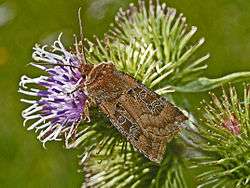Chersotis cuprea
Chersotis cuprea is a moth of the family Noctuidae.
| Chersotis cuprea | |
|---|---|
 | |
| Chersotis cuprea | |
| Scientific classification | |
| Kingdom: | |
| Phylum: | |
| Class: | |
| Order: | |
| Family: | |
| Genus: | |
| Species: | C. cuprea |
| Binomial name | |
| Chersotis cuprea Denis & Schiffermüller, 1775 | |
| Synonyms | |
| |
Subspecies
There are three recognised subspecies:
- Chersotis cuprea cuprea
- Chersotis cuprea japonica (Japan)
- Chersotis cuprea schaeferi (Eastern Tibet)
Description
Chersotis cuprea have a wingspan of 32–36 millimetres (1.3–1.4 in) in males, of 33–39 millimetres (1.3–1.5 in) in females. This species shows a high variability in the basic colors. Usually the upper side of the forewings is coppery reddish brown (hence the Latin name cuprea), with dark brown markings outlined in thin whitish. The underside of the forewing is dark gray-brown. The hind wings are monochrome gray-brown. Caterpillars are gray-brown, with dark dorsal markings and bright side stripes.[1]
Biology
The moth flies from July to September depending on the location. The larvae feed on Vaccinium myrtillus, on Asteraceae (Centaurea or Taraxacum) and on other plants.[2][3]
Distribution
This species can be found in Northern Europe, the Pyrenees, Central Europe down to Greece and east through the Ukraine, Siberia, Turkey, the Caucasus and Armenia, up to China and Japan.[2][4]
Habitat
These moths live in forests and in mountain forests, in nutrient-poor grasslands and especially in partly humid alpine pastures.[3]
Bibliography
- Michael Fibiger: Noctuinae II. - Noctuidae Europaeae, Volume 2. Entomological Press, Sorø, 1993, ISBN 87-89430-02-6
- Erstbeschreibung: (1775): Ankündung eines systematischen Werkes von den Schmetterlingen der Wienergegend herausgegeben von einigen Lehrern am k. k. Theresianum. 1-323, pl. I a+b, Frontispiz. Wien (Augustin Bernardi).
- LepIndex: The Global Lepidoptera Names Index. Beccaloni G.W., Scoble M.J., Robinson G.S. & Pitkin B.
- Manfred Koch: Wir bestimmen. Schmetterlinge. Band 3. Eulen. Neumann Verlag Radebeul 2. Auflage 1972
- Hochspringen Bundesamt für Naturschutz (Hrsg.): Rote Liste gefährdeter Tiere Deutschlands. Landwirtschaftsverlag, Münster 1998, ISBN 3-89624-110-9